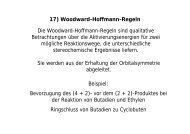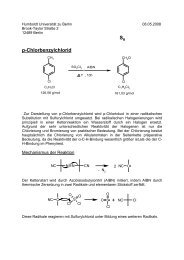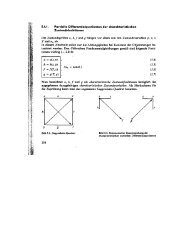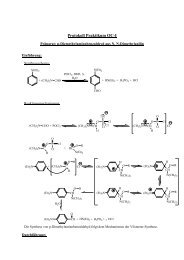Gas-Phase Reactions of Homo- and ... - Institut für Chemie
Gas-Phase Reactions of Homo- and ... - Institut für Chemie
Gas-Phase Reactions of Homo- and ... - Institut für Chemie
Create successful ePaper yourself
Turn your PDF publications into a flip-book with our unique Google optimized e-Paper software.
1416<br />
Helvetica Chimica Acta ± Vol. 88 (2005)<br />
analogy to the mechanism depicted in Scheme 4, <strong>and</strong> iii) an ion/dipole mechanism, in<br />
which the N-atom remains coordinated to the transition metal throughout the entire<br />
reaction sequence. The latter mechanism, prevailing for the late transition-metal<br />
cations Cu ‡ <strong>and</strong> Ni ‡ , might also be operative in the neutral products formed in<br />
<strong>Reactions</strong> 13, 14, <strong>and</strong> 23 as an alternative to the allylic mechanism, depicted in<br />
Scheme 4.<br />
For double dehydrogenation, the mechanism shown in Scheme 5 is compatible with<br />
the experimental data. Starting from the complex 21, reversible insertion in the allylic<br />
C H bond leads to 25, from which the second dehydrogenation may occur (25 ! 27).<br />
Alternatively, reversible insertion in a C H bond at the a position gives rise to the<br />
complex 26; from the latter, after additional allylic C H bond activation H 2 may be<br />
liberated to produce 27. We note in passing that in the course <strong>of</strong> these reactions the endon<br />
coordination mode indicated in structures 25, 26, <strong>and</strong> 27 most likely will change to a<br />
side-on coordination to the CN group.<br />
Scheme 5. Proposed Mechanism for the Double Dehydrogenation <strong>of</strong> Pentanenitrile by Ni ‡ 2<br />
Secondary <strong>Reactions</strong> <strong>of</strong> Co ‡ 2 , FeCo ‡ , <strong>and</strong> FeNi ‡ . Some secondary reactions observed<br />
in this study are noteworthy, <strong>and</strong> all are probably related to each other as well as to<br />
some <strong>of</strong> the primary reactions already mentioned above for Ni ‡ 2 <strong>and</strong> CoNi ‡ .<br />
[Co 2C 5H 7N] ‡ ‡ n-C 4H 9CN ! [Co 2C 8H 12N 2] ‡ ‡ C 2H 4<br />
[FeCoC 5H 7N] ‡ ‡ n-C 4H 9CN ! [FeCoC 6H 10N 2] ‡ ‡ C 4H 6<br />
[FeNiC 5H 7N] ‡ ‡ n-C 4H 9CN ! [FeNiC 6H 10N 2] ‡ ‡ C 4H 6<br />
(37)<br />
(38)<br />
(39)<br />
[FeNiC 5H 7N] ‡ ‡ n-C 4H 9CN ! [FeNiC 9H 13N] ‡ ‡ [CH 3N] (40)<br />
The product ion [Co 2C 5H 7N] ‡ reacts with a second molecule <strong>of</strong> pentanenitrile to<br />
form the complex ion [Co 2C 8H 12N 2] ‡ concomitant with loss <strong>of</strong> ethene (Eqn. 37). The<br />
possibility that the latter product ion is produced in a secondary reaction <strong>of</strong> the initially<br />
formed encounter complex [Co 2C 5H 9N] ‡ with pentanenitrile, associated with the loss<br />
<strong>of</strong> intact ethane, can be excluded by a double-resonance experiment, in which after


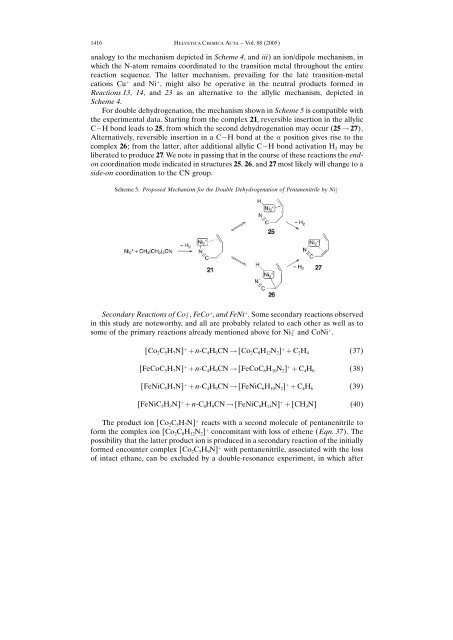
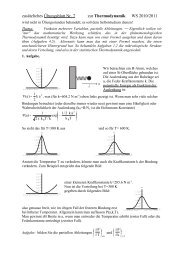
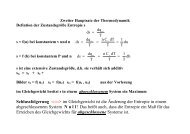
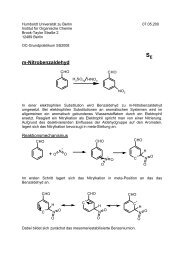
![Photoswitchable ionophores based on 1,3-alternate calix[4]arenes ...](https://img.yumpu.com/12290271/1/190x253/photoswitchable-ionophores-based-on-13-alternate-calix4arenes-.jpg?quality=85)
